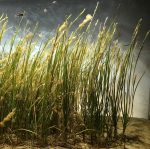 Also known as seawrack and tapegrass, eelgrass is a submerged perennial native to shallow marine environments from subtropical to subpolar regions of North America and Eurasia. It is a member of the eelgrass family, Zosteraceae, 1 of 4 seagrass families. It has a thick, creeping rhizome with many roots and nodes, and ribbon-like leaves with rounded tips and up to 47″ long. Male and female flowers are produced on the same plant in late spring and female flowers give rise to nutlets containing seeds that are produced on spathes that break off, rise to the surface, drift, and release the seeds. Plants reproduce asexually from shoots produced by the rhizome and may form colonies. Eelgrass is valued for its many uses including as packing material, stuffing, food for humans and animals, fertilizer, insulation, and roof thatching material. In addition, eelgrass is useful for soil stabilization and provides habitats for blue crabs, mussels, and fish. The genus name, Zostera, comes from the Greek word, zōstēr, meaning girdle. The specific epithet, marina, comes from the Latin word mare, meaning sea and refers to it habitat.
Also known as seawrack and tapegrass, eelgrass is a submerged perennial native to shallow marine environments from subtropical to subpolar regions of North America and Eurasia. It is a member of the eelgrass family, Zosteraceae, 1 of 4 seagrass families. It has a thick, creeping rhizome with many roots and nodes, and ribbon-like leaves with rounded tips and up to 47″ long. Male and female flowers are produced on the same plant in late spring and female flowers give rise to nutlets containing seeds that are produced on spathes that break off, rise to the surface, drift, and release the seeds. Plants reproduce asexually from shoots produced by the rhizome and may form colonies. Eelgrass is valued for its many uses including as packing material, stuffing, food for humans and animals, fertilizer, insulation, and roof thatching material. In addition, eelgrass is useful for soil stabilization and provides habitats for blue crabs, mussels, and fish. The genus name, Zostera, comes from the Greek word, zōstēr, meaning girdle. The specific epithet, marina, comes from the Latin word mare, meaning sea and refers to it habitat.
Type: Submerged, marine perennial
Bloom: Male and female flowers on the same plant in late spring
Size: 3.3′ H
Light: Full sun
Soil: Sandy sediment in saline water 16′ or less deep
Hardiness: Unavailable
Care: Not relevant
Pests and Diseases: Labyrinthula zosterae
Propagation: Seed, division
Companion Plants: Not applicable
Photo Credit:Wikipedia